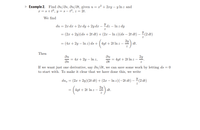
Calculus: Early Transcendentals
8th Edition
ISBN: 9781285741550
Author: James Stewart
Publisher: Cengage Learning
expand_more
expand_more
format_list_bulleted
Question
![The subscript s indicates that s is being held constant. Then dividing by dt, we
have du/dt as before. We could also use derivatives instead of differentials. By an
equation like (5.1), we have
du dz
əz ət
ди
ди дх
ди ду
(7.2)
Əx dt
dy dt
where we have written all thet derivatives as partials since u, x, y, and z depend
on both s and t. Using (7.2), we get
du
= (2x + 2y)(2t)+ (2x – In z)(-2t) +
(-2) (2) = 4yt + 2t ln z –
2y
It is sometimes useful to write chain rule formulas in matrix form (for matrix
multiplication, see Chapter 3, Section 6). Given, as above, u = f(x,y, z), x(s, t),
y(s, t), z(s,t), we can write equations like (7.2) in the following matrix form:
as
ди ди
ds dt
ди ди ди
dx dy dz,
ду
ду
(7.3)
ds
dz
dz
ds
dt
Sometimes (7.3) is written in the abbreviated form
d(u)
a(s,t)
a(u) a(x, y, z)
d(x, y, z) d(s,t)
which is reminiscent of
dy
dy dx
%3D
dt
dx dt
but be careful of this for two reasons: (a) It may be helpful in remembering the
formula but to use it you must understand that it means the matrix product (7.3).
(b) The symbol d(u, v)/a(x, y) usually means a determinant rather than a matrix
of partial derivatives see Chapter 5, Section 4].
Again in these problems, you may say, why not just substitute? Look at the
following problem.](https://content.bartleby.com/qna-images/question/ab776f79-d15e-4871-96c0-7ec59008ecc3/6a40ce13-1e11-48f8-a7cd-4f499dfac432/8hdpmz_thumbnail.png)
Transcribed Image Text:The subscript s indicates that s is being held constant. Then dividing by dt, we
have du/dt as before. We could also use derivatives instead of differentials. By an
equation like (5.1), we have
du dz
əz ət
ди
ди дх
ди ду
(7.2)
Əx dt
dy dt
where we have written all thet derivatives as partials since u, x, y, and z depend
on both s and t. Using (7.2), we get
du
= (2x + 2y)(2t)+ (2x – In z)(-2t) +
(-2) (2) = 4yt + 2t ln z –
2y
It is sometimes useful to write chain rule formulas in matrix form (for matrix
multiplication, see Chapter 3, Section 6). Given, as above, u = f(x,y, z), x(s, t),
y(s, t), z(s,t), we can write equations like (7.2) in the following matrix form:
as
ди ди
ds dt
ди ди ди
dx dy dz,
ду
ду
(7.3)
ds
dz
dz
ds
dt
Sometimes (7.3) is written in the abbreviated form
d(u)
a(s,t)
a(u) a(x, y, z)
d(x, y, z) d(s,t)
which is reminiscent of
dy
dy dx
%3D
dt
dx dt
but be careful of this for two reasons: (a) It may be helpful in remembering the
formula but to use it you must understand that it means the matrix product (7.3).
(b) The symbol d(u, v)/a(x, y) usually means a determinant rather than a matrix
of partial derivatives see Chapter 5, Section 4].
Again in these problems, you may say, why not just substitute? Look at the
following problem.

Transcribed Image Text:Example 2. Find du/ðs, du/dt, given u = x² + 2xy – y ln z and
x = s+t2, y= s – t2, z = 2t.
We find
du = 2x dx + 2x dy + 2y dx – 2dz – In z dy
= (2x + 2y)(ds + 2t dt) + (2x – In 2)(ds – 2t dt) – 2 (2 dt)
2y
= (4x + 2y – In z) ds + ( 4yt + 2t ln z –
dt.
Then
ди
= 4x + 2y – In z,
ди
= 4yt + 2t I z
2y
Əs
If we want just one derivative, say du/at, we can save some work by letting ds = 0
to start with. To make it clear that we have done this, we write
(2 dt)
du, = (2x + 2y)(2t dt) + (2x – In z)(-2t dt) –
2y
4yt + 2t ln z
dt.
Expert Solution
This question has been solved!
Explore an expertly crafted, step-by-step solution for a thorough understanding of key concepts.
This is a popular solution
Trending nowThis is a popular solution!
Step by stepSolved in 3 steps

Knowledge Booster
Similar questions
Recommended textbooks for you
 Calculus: Early TranscendentalsCalculusISBN:9781285741550Author:James StewartPublisher:Cengage Learning
Calculus: Early TranscendentalsCalculusISBN:9781285741550Author:James StewartPublisher:Cengage Learning Thomas' Calculus (14th Edition)CalculusISBN:9780134438986Author:Joel R. Hass, Christopher E. Heil, Maurice D. WeirPublisher:PEARSON
Thomas' Calculus (14th Edition)CalculusISBN:9780134438986Author:Joel R. Hass, Christopher E. Heil, Maurice D. WeirPublisher:PEARSON Calculus: Early Transcendentals (3rd Edition)CalculusISBN:9780134763644Author:William L. Briggs, Lyle Cochran, Bernard Gillett, Eric SchulzPublisher:PEARSON
Calculus: Early Transcendentals (3rd Edition)CalculusISBN:9780134763644Author:William L. Briggs, Lyle Cochran, Bernard Gillett, Eric SchulzPublisher:PEARSON Calculus: Early TranscendentalsCalculusISBN:9781319050740Author:Jon Rogawski, Colin Adams, Robert FranzosaPublisher:W. H. Freeman
Calculus: Early TranscendentalsCalculusISBN:9781319050740Author:Jon Rogawski, Colin Adams, Robert FranzosaPublisher:W. H. Freeman
 Calculus: Early Transcendental FunctionsCalculusISBN:9781337552516Author:Ron Larson, Bruce H. EdwardsPublisher:Cengage Learning
Calculus: Early Transcendental FunctionsCalculusISBN:9781337552516Author:Ron Larson, Bruce H. EdwardsPublisher:Cengage Learning

Calculus: Early Transcendentals
Calculus
ISBN:9781285741550
Author:James Stewart
Publisher:Cengage Learning

Thomas' Calculus (14th Edition)
Calculus
ISBN:9780134438986
Author:Joel R. Hass, Christopher E. Heil, Maurice D. Weir
Publisher:PEARSON

Calculus: Early Transcendentals (3rd Edition)
Calculus
ISBN:9780134763644
Author:William L. Briggs, Lyle Cochran, Bernard Gillett, Eric Schulz
Publisher:PEARSON

Calculus: Early Transcendentals
Calculus
ISBN:9781319050740
Author:Jon Rogawski, Colin Adams, Robert Franzosa
Publisher:W. H. Freeman


Calculus: Early Transcendental Functions
Calculus
ISBN:9781337552516
Author:Ron Larson, Bruce H. Edwards
Publisher:Cengage Learning